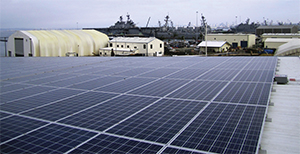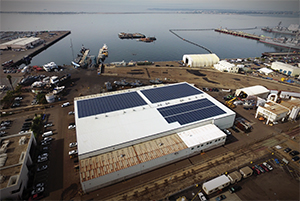For zero-emission, low-impact boatbuilder Marine Group Boat Works, installing a rooftop solar system on its massive fabrication building in San Diego was more than a matter of good business sense.
“There’s no question that solar is an economic benefit, but there are many other advantages — everything from self-reliance and sustainability to doing the right thing,” said Todd Roberts, president of MGBW, a tenant of the Port of San Diego.
MGBW is a mid-sized, family-owned boatbuilding and repair company with two facilities located on San Diego Bay in Chula Vista and National City, and a third in Mexico that total over 1.3 million square feet. In December, it announced that it had installed a 500-kW solar panel system atop its 35,000-square-foot facility in National City. The site has five work bays, each with a 10-ton overhead crane. MGBW claims it is the first boatbuilder in the United States to use solar energy to build vessels.
The new system will greatly decrease MGBW’s carbon footprint and is expected to reduce annual energy consumption by 81 percent based on past and projected usage, the boatbuilder stated. According to the Environmental Protection Agency’s Greenhouse Gas Equivalencies Calculator, each year the system will reduce emissions equivalent to 1.21 million miles driven by an average passenger vehicle.
Matt Van Note, commercial solar consultant for Baker Electric Solar of Escondido, Calif., said the $1.2 million, 500-kW rooftop system comprises 1,558 solar panels installed in conjunction with a new metal roof, which was necessary to safely accommodate the system.
The corrugated roof allowed for “an extremely cost-effective installation for the company,” Van Note said. “Corrugated metal or standing-seam roofs make for a perfect surface for solar installation.” For marine environments, solar panels are treated with a rust-resistant coating.
The six-month project included permitting, design and seismic retrofits on the building to bring it up to code for safe solar installation. “It is rare to need seismic work for solar since it’s so lightweight, but this was a 1960s-era building,” Van Note said.
While MGBW has wanted to go solar for the past several years, energy consumption from boat repair was simply not great enough to warrant the investment, the boatbuilder stated. However, since MGBW opened its new construction division in National City, increases in manufacturing and production — made possible by U.S. Navy and commercial newbuild contracts and facility upgrades — made the timing good.
 |
|
Marine Group Boat Works says it is the first U.S. yard to use solar energy to build vessels. |
|
Courtesy Baker Electric Solar |
The system will provide more than $3 million in net savings over the 25-year warranted life of the solar modules, according to Baker Electric Solar. Return on the initial investment is expected to take about five years.
“We figured we would get a five- to seven-year payback and reduce our dependence (on traditional energy suppliers),” Roberts said. “Energy is a very fluid issue in California, with lots of peak and off-peak charges. We’re trying to wean our dependence on the grid, and putting in a 500-kW array is the first place to start.”
MGBW’s commitment to sustainability and low-impact construction earned the boatbuilder the 2016 Renewable Energy Sustainability Achievement Award from the Port of San Diego.
In addition to the solar installation, MGBW reclaims 100 percent of stormwater runoff without discharging any water into the bay. Sandblasting and painting are done in enclosures where all used materials are captured and recycled when possible.
For the transportation of labor and materials between its San Diego Bay facilities, MGBW bought a fleet of electric cars and electric forklifts to further reduce its carbon footprint.
“Now we have electric car charging that ties into our solar system and complimentary car charging for our employees,” Roberts said. “Three of our employees bought electric cars and I bought an electric bike.”
Roberts said he is not aware of solar installations at other shipyards.
“That is shocking since we are such huge consumers of electricity,” he said. “Our power bills are well over $1 million a year.”
For those considering solar systems, Roberts recommends paying special attention to quality and output since “there’s a gold rush for solar now.”
“There are good solar panels and bad ones — output can vary for the same size panel,” he said. “Study the economics carefully with a qualified consultant.”

